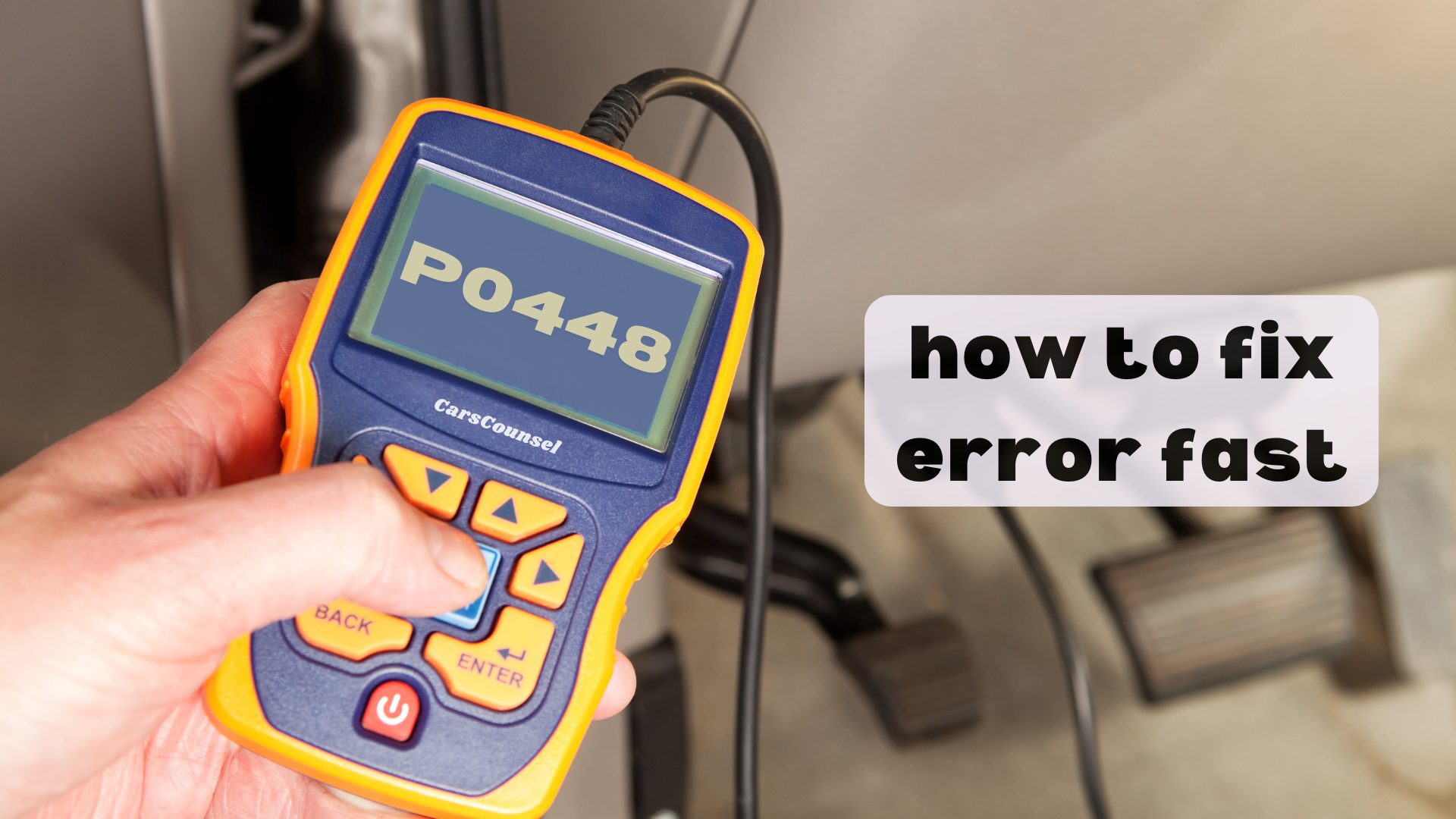You’re driving down the highway when your check engine light suddenly illuminates. You pull over to find the code P0448 on your dashboard, indicating an issue with your Evaporative Emission Control System’s Vent Control Circuit Close.
This system is responsible for regulating harmful gas emissions from your fuel system, so it’s essential to address the problem promptly. But what exactly is causing the issue, and how do you fix it?
Is it a faulty vent control solenoid, wiring issues, or something else entirely? You’ll need to dig deeper to find the root cause and get your vehicle running smoothly again.

Quick Navigation
Key Takeaways
- The P0448 code indicates a problem with the Evaporative Emission Control System’s Vent Control Circuit Close, affecting emission regulation compliance.
- Common causes of the P0448 code include a faulty vent control solenoid, wiring issues, a clogged charcoal canister, and a loose or damaged fuel cap.
- The symptoms of the P0448 code include an illuminated check engine light, rough idle, a strong fuel smell, failure to pass the emissions test, and poor engine performance.
- Diagnosis involves using a fault code reader or scan tool, performing system checks, and inspecting wiring and connections for corrosion or damage.
- Repair typically involves replacing the vent control solenoid, repairing wiring issues, and testing the system to ensure the code is no longer present.
Code P0448 Description
The P0448 code refers to a specific problem within your vehicle’s Evaporative Emission Control System, specifically the Vent Control Circuit Close.
This system is responsible for controlling the emission of harmful gases from your fuel system, ensuring your vehicle complies with emission regulations.
The Vent Control Circuit Close regulates the flow of vapors from the fuel tank to the charcoal canister, where they are stored and later combusted in the engine.
When this circuit malfunctions, it can lead to issues with emissions control, affecting your vehicle’s performance and environmental impact.
The Evaporative Emission Control System is designed to reduce the emission of harmful gases into the atmosphere, making it a critical component of your vehicle’s overall emission control strategy.
Common Causes of P0448
Faulty components and system malfunctions can trigger the P0448 code, and identifying the root cause is crucial for effective repairs.
You’ll need to investigate the vent control circuit closely to determine the source of the issue. A faulty vent control solenoid, for instance, can prevent the system from regulating vapour flow properly.
Wiring issues, such as corrosion or loose connections, can also trigger the code. Additionally, a clogged or damaged charcoal canister or a loose or damaged fuel cap can impact the system’s ability to function correctly.
Other electrical or mechanical faults in the system can also cause the P0448 code, so it’s essential to perform a thorough diagnosis to identify the root cause.
Symptoms of P0448 Code
When you encounter a P0448 code, you’ll likely notice some telltale signs that something’s amiss.
One of the most obvious symptoms is the check engine light on your dashboard being illuminated.
You might also experience a rough idle or inconsistent engine performance, which can be frustrating and affect your vehicle’s overall performance.
Additionally, you might notice a strong fuel smell, especially around the fuel tank, indicating a potential fuel leak.
If your vehicle fails an emissions test, it could be due to increased emissions caused by a malfunction in the system.
Poor engine performance or decreased fuel efficiency may also be symptoms of the P0448 code, making it essential to address the issue promptly.
How to Fix P0448 Code
Get to the root of the problem by diagnosing the issue with a diagnostic scanner, which will help you pinpoint the exact cause of the P0448 code. This will give you a clear direction for repair. Once you’ve identified the issue, you can start making repairs to get your vehicle running efficiently again.
| Repair Step | Importance for Fuel Efficiency and Emission Standards |
|---|---|
| Inspect and replace vent control solenoid | Pivotal for regulating vapor flow and meeting emission standards |
| Check and repair wiring issues | Essential for maintaining proper system function and fuel efficiency |
| Test system after repairs | Critical for verifying the code is no longer present and the system is functioning correctly |
| Consult a professional mechanic if needed | Recommended for complex issues to guarantee proper repair and minimize environmental impact
Diagnosing the Issue
Tap into the diagnostic process by hooking up a code reader or scan tool to your vehicle’s onboard computer. This will help you retrieve the trouble code and pinpoint the exact issue.
Next, perform system checks to identify any faults in the evaporative emission control system. Check the vent control circuit close for any signs of malfunction, and inspect the wiring and connections for corrosion or damage.
Use fault detection techniques to isolate the problem area and determine the root cause of the issue. This will give you a clear direction for repairs and guarantee that you’re addressing the correct problem.
Vent Control Solenoid Inspection
Inspecting the vent control solenoid is a crucial step in diagnosing the root cause of the P0448 code.
You’ll want to check the solenoid for any signs of damage, corrosion, or worn-out components. Make certain to perform solenoid maintenance by cleaning the electrical connections and checking for any loose or corroded wires.
Inspect the solenoid’s coil for any signs of burnout or overheating. Use a multimeter to test the solenoid’s resistance and voltage output. Compare your readings to the manufacturer’s specifications to determine if the solenoid is functioning properly.
If you find any issues, consider replacing the vent control solenoid to guarantee proper system operation.
Wiring Issues and Repairs
When diagnosing wiring issues in the vent control circuit close, you’ll need to scrutinize the entire circuit, tracing the wires from the vent control solenoid to the engine control module, and identify any damage, corrosion, or loose connections that could be causing the P0448 code.
Use a Spark Tester to check for voltage drops or shorts in the circuit. Inspect the Wiring Harness for signs of wear, damage, or corrosion, and repair or replace it as needed.
Check for loose connections at the vent control solenoid, engine control module, and any other components in the circuit. Make sure to consult a wiring diagram specific to your vehicle make and model to certify accurate diagnosis and repair, and verify that all connections are secure to guarantee a reliable fix.
Testing the Evaporative System
The fuel tank’s vapor-laden atmosphere is where your testing journey begins. You’ll need to inspect the system components, focusing on the vent control solenoid, charcoal canister, and fuel cap. Perform pressure tests to identify any leaks or blockages in the system.
| Component | Test Method | Expected Result |
|---|---|---|
| Vent Control Solenoid | Apply 12V to the solenoid | Should open and close freely |
| Charcoal Canister | Inspect for blockages or damage | Should be free of debris and damage |
| Fuel Cap | Inspect for proper sealing | Should seal tightly to prevent vapor escape |
| EVAP System Hoses | Inspect for cracks or damage | Should be free of cracks and damage |
| Purge Valve | Apply vacuum to the valve | Should hold vacuum and not leak |
Cost to Fix P0448 Code
About 75% of P0448 code repairs fall within the $150 to $500 range, depending on the underlying cause and labor rates.
When planning your budget for this repair, you’ll want to weigh the cost of parts, which can range from $50 to $200, and labor costs, which can range from $100 to $300.
Your total cost will depend on the complexity of the issue and the shop’s labor rates. To get an accurate repair estimate, it’s essential to have a professional mechanic diagnose the problem and provide a detailed breakdown of the necessary repairs.
Repair Importance and Difficulty
You’ve received a P0448 code diagnosis, and now you’re considering the repair importance and difficulty level to plan your next steps.
The repair importance level is 1 (Low), indicating that the issue isn’t critical and can be addressed at your convenience. However, the repair difficulty level is 3 (Hard), suggesting that you may need professional assistance.
When it comes to repair timelines, you can expect the following:
- Diagnostic time: 1-2 hours
- Repair time: 2-5 hours
- Total downtime: 3-7 hours
Shop estimates will vary depending on labor rates and the specific repairs needed. Be sure to get a detailed estimate from your mechanic before proceeding with the repair.
Additional Information and Resources
Precision is key when delving into the world of evaporative emission control system repairs, and having access to the right resources can make all the difference.
You’ll want to familiarize yourself with emissions regulations and vehicle maintenance guidelines specific to your make and model. Consult factory service manuals and online forums to gain a deeper understanding of the evaporative emission control system and its components.
Additionally, research local emissions testing procedures and requirements to guarantee your vehicle is compliant. Having a comprehensive understanding of these resources will empower you to tackle the P0448 code with confidence and make informed decisions about your vehicle’s maintenance and repair.
More OBD-II Codes
Frequently Asked Questions
Will a Faulty Vent Control Solenoid Cause My Car to Stall?
You’re wondering if a faulty vent control solenoid will cause your car to stall. Yes, it’s possible, as a vent malfunction can disrupt the engine’s air-fuel mixture, leading to stalling or rough idling, especially when the faulty sensor prevents proper vapor flow regulation.
Can I Drive My Car With a P0448 Code Safely?
You can drive your car with a P0448 code, but be aware that it may impact emission control, affecting the environment and your vehicle’s performance, so adjust your driving habits to minimize the negative effects until repairs are made.
Will a P0448 Code Affect My Car’s Gas Mileage?
You’ll likely notice a decrease in fuel efficiency, as a malfunctioning evaporative emission control system can lead to increased emissions, violating emission standards, and ultimately affecting your car’s gas mileage, making it less environmentally friendly and more costly to run.
Can a P0448 Code Be Triggered by Low Fuel Levels?
You’re wondering if low fuel levels can trigger a P0448 code. Yes, they can, as low fuel levels can cause changes in fuel pump pressure and fuel system vacuum, which may affect the vent control circuit close, leading to the code.
Will a P0448 Code Clear Itself Over Time?
You shouldn’t expect a P0448 code to clear itself over time; instead, you’ll need to address the underlying issue, such as cleaning or replacing the vent control solenoid, to resolve the problem and trigger a code reset.
Conclusion
As you’ve seen, the P0448 code is a serious issue that requires prompt attention. Did you know that a faulty evaporative emission control system can release up to 20 gallons of fuel vapor into the atmosphere per year? That’s equivalent to driving 1,500 miles without a catalytic converter! Fixing the P0448 code is vital not only for your car’s performance but also for the environment. By following the steps outlined above, you’ll be able to diagnose and repair the issue, ensuring a smoother ride and a clearer conscience.

